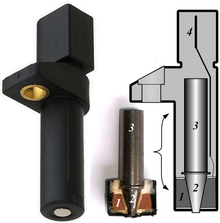Crankshaft position sensor

A crank sensor is an electronic device used in an internal combustion engine to monitor the position or rotational speed of the crankshaft. This information is used by engine management systems to control the fuel injection or the ignition system timing and other engine parameters. Before electronic crank sensors were available, the distributor would have to be manually adjusted to a timing mark on the engine.
The crank sensor can be used in combination with a similar camshaft position sensor to monitor the relationship between the pistons and valves in the engine, which is particularly important in engines with variable valve timing. This method is also used to "synchronise" a four stroke engine upon starting, allowing the management system to know when to inject the fuel. It is also commonly used as the primary source for the measurement of engine speed in revolutions per minute.
Common mounting locations include the main crank pulley, the flywheel, the camshaft or on the crankshaft itself. This sensor is the 2nd most important sensor in modern day engines after the camshaft position sensor. When it fails, there is a chance the engine will not start, or cut out while running.
Types of sensor
Commonly a hall effect sensor is used, which is placed adjacent to a spinning steel disk. Other detection principles can be employed such as an optical sensor or inductive sensor.
Some engines, such as GM's Premium V family, use crank position sensors which read a reluctor ring integral to the harmonic balancer. This is a much more accurate method of determining the position of the crankshaft, and allows the computer to determine within a few degrees the exact position of the crankshaft (and thereby all connected components) at any given time.
Function
The functional objective for the crankshaft position sensor is to determine the position and/or rotational speed (RPM) of the crank. Engine Control Units use the information transmitted by the sensor to control parameters such as ignition timing and fuel injection timing. The sensor output can also be related to other sensor data including the cam position to derive the current combustion cycle, this is very important for the starting of a four stroke engine.
Sometimes, the sensor may become burnt or worn out. The most likely causes of crankshaft position sensor failure are exposure to extreme heat. Many modern crankshaft sensors are closed units and therefore will not be damaged by water or other fluids. When it goes bad, it stops transmitting the signal which contains the vital data for the ignition and other parts in the system.
A bad crank position sensor can worsen the way the engine idles, the pistons fire, or the acceleration behavior. If the engine is revved up with a bad or faulty sensor, it may cause misfiring, motor vibration or backfires. Accelerating might be hesitant, and abnormal shaking during engine idle might occur. In the worst case the car may not start.
The first sign of crankshaft sensor failure, usually, is the refusal of the engine to start when hot but will start again once the engine has cooled.
Bicycles
Another type of crank sensor is used on bicycles to monitor the position of the crankset, usually for the cadence readout of a cyclocomputer. These are usually reed switches mounted on the bicycle frame with a corresponding magnet attached to one of the pedal crankset arms.
Notes
GMR (giant magnetoresistance) technology is also used for Crank, Cam rotor sensing purpose. Mitsubishi is the first who used this technology in automotive application purpose.